Lillian Hetet-Owen
EXHIBITION / Remembering LEGACY: The Art of Rangi Hetet and Erenora Puketapu-Hetet
Video: Hightlight reel of the exhibition LEGACY: The Art of Rangi Hetet and Erenora Puketapu-Hetet, Dowse Art Museum 26 June - 30 October 2016. More details about the exhibition can be found on the Dowse website (please click here to view).
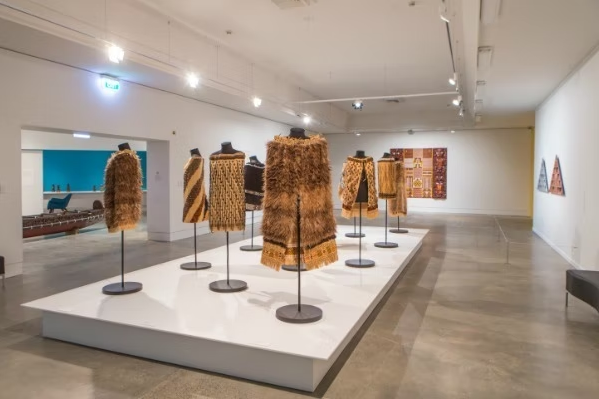
Venue: The Dowse Art Museum, Hutt City, Wellington, Aotearoa New Zealand
Date: June - October 2016
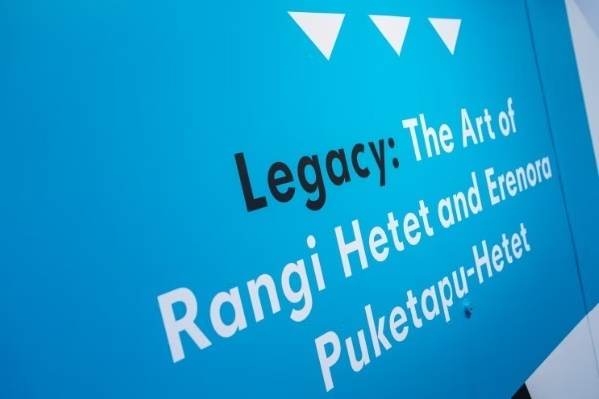
On a plinth, at the entrance to the six-gallery exhibition, a simple mussel shell and a mallet are displayed.
Just beyond, a photograph of my mother Erenora and my father Rangi smiling on their 45th Wedding Anniversary welcomes visitors. The simplicity of that first exhibit belies the breadth of what is on show within: highlights from a creative partnership that spanned more than forty years.
Just beyond, a photograph of my mother Erenora and my father Rangi smiling on their 45th Wedding Anniversary welcomes visitors. The simplicity of that first exhibit belies the breadth of what is on show within: highlights from a creative partnership that spanned more than forty years.
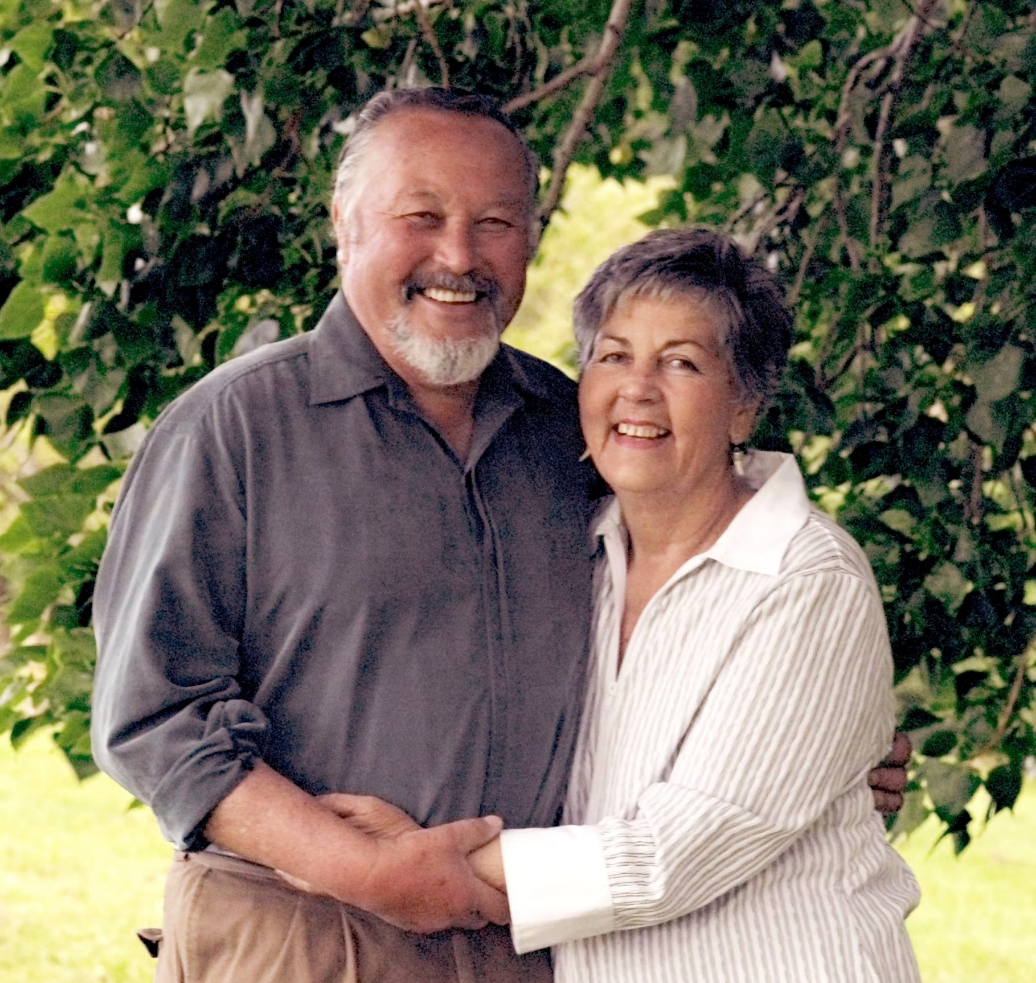
As co-curator of the exhibition, my first job was to convince my father that an exhibition of his carving and Mum’s weaving was warranted. Dad was happy for Mum’s work to be on show but reluctant for his own until I reminded him that carving and weaving go together and that this exhibition was more about Māori Art than it was about them as individual artists.
We decided the words of Dad’s grandmother, Nana Rangimarie, should grace the wall in the main gallery since they truly encapsulate the kaupapa of the exhibition and indeed of Mum and Dad’s artistic life – practising, teaching and creating together.
E ngā uri whakatupu, whakarongo, kia kaha
Hapainga ake rā ngā mahi hua tau a ngā tūpuna i waiho ake nei
Hei painga mo te iwi o Aotearoa e
O coming generations, listen, be strong
Uplift the arts left by our ancestors
for the good of the people of Aotearoa
The main exhibit in the first gallery is a procession of twelve cloaks displayed unimpeded by cabinetry. There’s something about putting kãkahu behind glass that consigns this beautiful art form to the past.
Showing the cloaks being worn reminds us what they are for and that they are still very much a part of contemporary Māori life - which is something Mum was always keen to promote. The cloak Te Papa commissioned for the opening of the museum is among them. Mum asked it be used rather than stored away and suggested it be placed on special guests. Visiting the museum, the brother of designer Versace said it was the most beautiful thing he had ever worn. Of course, kahukiwi always have a way of making people feel special no matter who the weaver.
We decided the words of Dad’s grandmother, Nana Rangimarie, should grace the wall in the main gallery since they truly encapsulate the kaupapa of the exhibition and indeed of Mum and Dad’s artistic life – practising, teaching and creating together.
E ngā uri whakatupu, whakarongo, kia kaha
Hapainga ake rā ngā mahi hua tau a ngā tūpuna i waiho ake nei
Hei painga mo te iwi o Aotearoa e
O coming generations, listen, be strong
Uplift the arts left by our ancestors
for the good of the people of Aotearoa
The main exhibit in the first gallery is a procession of twelve cloaks displayed unimpeded by cabinetry. There’s something about putting kãkahu behind glass that consigns this beautiful art form to the past.
Showing the cloaks being worn reminds us what they are for and that they are still very much a part of contemporary Māori life - which is something Mum was always keen to promote. The cloak Te Papa commissioned for the opening of the museum is among them. Mum asked it be used rather than stored away and suggested it be placed on special guests. Visiting the museum, the brother of designer Versace said it was the most beautiful thing he had ever worn. Of course, kahukiwi always have a way of making people feel special no matter who the weaver.
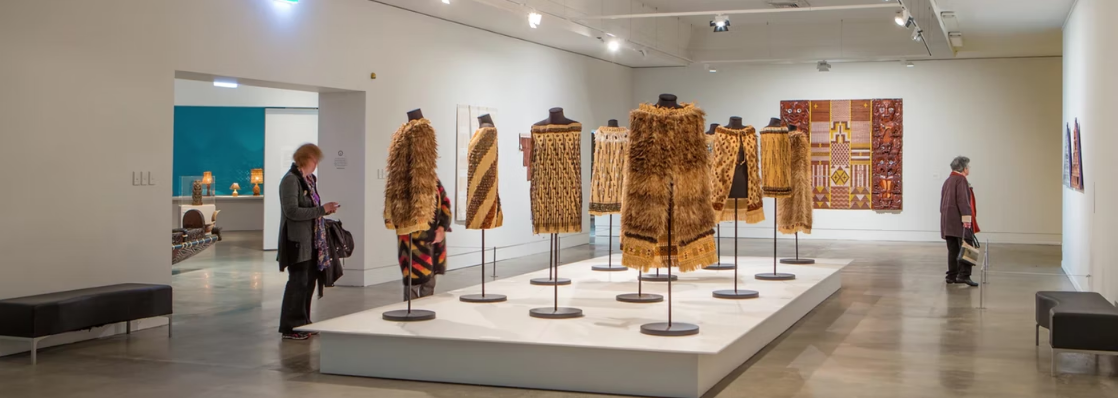
A procession of handwoven kākahu in Gallery One at The Dowse Cloaks woven by Erenora Puketapu-Hetet, Rangimarie Hetet and Veranoa Hetet Photo by Jeff McEwan 2016
There’s another Mum wove for Sir Paul Reeve’s when he became Governor General. She invited other Te Atiawa women to join her, weaving a few stitches or a row. That way he would be cloaked in all of their aroha. Two of Nana’s korowai are there also. The one she made for my grandfather is, to me, one of the most exquisite. The other Nana made for Dad. Kiri Te Kanawa was photographed wearing it before she left for London on her singing career. There are so many stories that become part of each cloak over time.
With so many in reaching distance, naturally, the staff of The Dowse worried that visitors would be tempted to touch the cloaks. We also knew that weavers, especially, would want to see the whatu. So it was heart warming to hear the story of two women who Dowse staff chanced upon one day, lying on the wide plinth beneath the cloaks looking upward, adhering respectfully to the ‘no touching’ policy whilst doing what comes naturally to weavers: observing the underside.
Many people have visited the exhibition in the first few months and have spoken of the awe they feel viewing so many kākahu together. I understand their response. I am not a weaver. That gene skipped me and went to my daughter, Sophie. However, I have seen a great deal of weaving in my life and it never ceases to amaze me that with a shell, a bunch of flax and a few dead birds, some of the most beautiful garments can be created. That’s an oversimplification, I know. I’ve watched the women of my whānau weave kākahu many times and I bow to all weavers for the dexterity, patience and persistence it takes to complete one cloak let alone many.
With so many in reaching distance, naturally, the staff of The Dowse worried that visitors would be tempted to touch the cloaks. We also knew that weavers, especially, would want to see the whatu. So it was heart warming to hear the story of two women who Dowse staff chanced upon one day, lying on the wide plinth beneath the cloaks looking upward, adhering respectfully to the ‘no touching’ policy whilst doing what comes naturally to weavers: observing the underside.
Many people have visited the exhibition in the first few months and have spoken of the awe they feel viewing so many kākahu together. I understand their response. I am not a weaver. That gene skipped me and went to my daughter, Sophie. However, I have seen a great deal of weaving in my life and it never ceases to amaze me that with a shell, a bunch of flax and a few dead birds, some of the most beautiful garments can be created. That’s an oversimplification, I know. I’ve watched the women of my whānau weave kākahu many times and I bow to all weavers for the dexterity, patience and persistence it takes to complete one cloak let alone many.
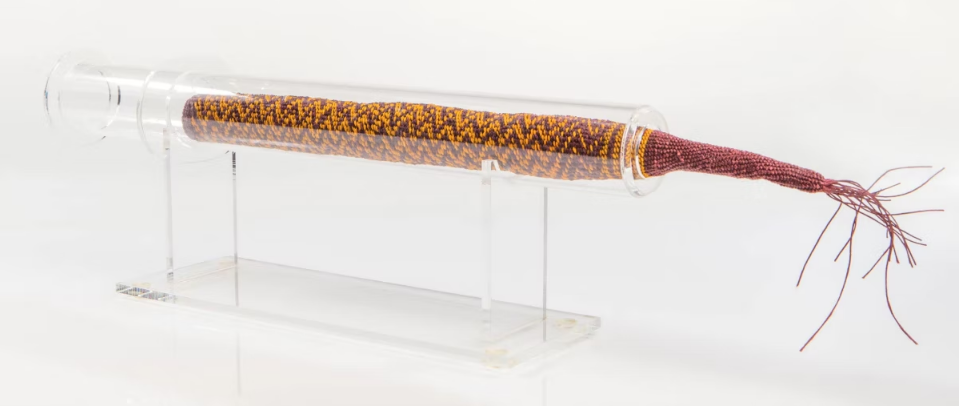
IVF- What of Whakapapa? Taaniko by Erenora Puketapu-Hetet Photo by Jeff McEwan
I won’t tell you about the taaniko in gallery six or the wall of kete and maro that fill the second gallery or the metal cloak in the third that gazes toward the procession of cloaks. They seem to be calling to each other from the past to the future and back again. Perhaps you will be able to visit the exhibition before it ends and see for yourself the extent of my mother’s love of weaving.
As mentioned, included in the exhibition are kākahu woven by Nana Rangimarie, a joint piece woven by Nana, Mum and my grandmother Lillian (nee Smallman) Hetet as well as one started by Mum in the year of her passing and finished with willing but heavy heart by my sister Veranoa with the help of her daughter Erenora.
A year before the exhibition, I asked Veranoa and her husband Sam to create works especially for the show to acknowledge what they have learned from our parents. Sam carved the most exquisite hoe. It is just as beautiful at the back as it is at the front, in keeping with our father’s teaching. Veranoa wove a piece for Dad incorporating the things he taught her - kowhaiwhai and tukutuku. For Mum, Veranoa painstakingly wove whatu and taaniko squares of natural coloured muka with hints of gold and stitched them together into a quilt hemmed with raranga woven from fabric. She called it ‘Ki taku uma piri ai’. There is enough muka in that piece for two and a half full-sized korowai and a ton of love to match.
As mentioned, included in the exhibition are kākahu woven by Nana Rangimarie, a joint piece woven by Nana, Mum and my grandmother Lillian (nee Smallman) Hetet as well as one started by Mum in the year of her passing and finished with willing but heavy heart by my sister Veranoa with the help of her daughter Erenora.
A year before the exhibition, I asked Veranoa and her husband Sam to create works especially for the show to acknowledge what they have learned from our parents. Sam carved the most exquisite hoe. It is just as beautiful at the back as it is at the front, in keeping with our father’s teaching. Veranoa wove a piece for Dad incorporating the things he taught her - kowhaiwhai and tukutuku. For Mum, Veranoa painstakingly wove whatu and taaniko squares of natural coloured muka with hints of gold and stitched them together into a quilt hemmed with raranga woven from fabric. She called it ‘Ki taku uma piri ai’. There is enough muka in that piece for two and a half full-sized korowai and a ton of love to match.
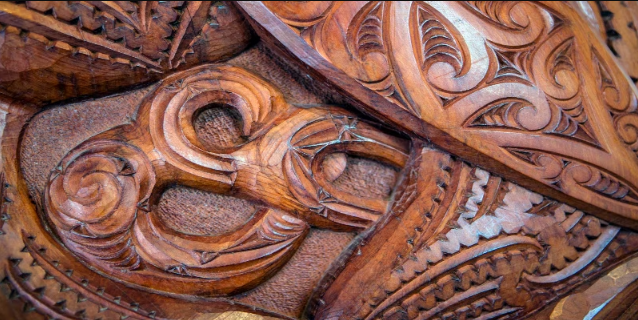
From a Pou commissioned by The Dowse Art Museum and carved by Rangi Hetet Photo by Jeff McEwan
In case you were wondering – Dad’s work is there too, gracing the walls and pillars, surrounding and supporting what Mum has made alongside pieces by their children including Kataraina and Len, and some of their mokopuna. The exhibition speaks about the balance between the masculine and feminine, wood and fibre, the curvilinear and the geometric, the soft and pliable with the rigid and inflexible, the old and new, as well as the past, present and future. I hope it gives visitors a palpable sense of the creative life of a carver and a weaver and their role as storytellers as well as teachers passing on a legacy for future generations. I’d like to think that visitors to the exhibition are surprised by what they have seen and leave uplifted by the wondrous arts of our ancestors.
Kia Ora,
Lillian Hetet-Owen
Footnote: Veranoa Hetet continues the legacy of teaching weaving via the hetetschoolofmaoriart.com using ‘The Matrix’ – a specific series of lessons that she and Erenora, developed over years of teaching students to weave. The school has students throughout Aotearoa, Australia and other parts of the world learning raranga, whatu and taaniko online. Veranoa's husband, Sam Hauwaho, continues to teach carving as his father-in-law taught him. Online carving lessons are in the pipeline. So the legacy continues.
This article was written for Te Roopu Raranga o Aotearoa's newsletter while the exhibition was on.
Kia Ora,
Lillian Hetet-Owen
Footnote: Veranoa Hetet continues the legacy of teaching weaving via the hetetschoolofmaoriart.com using ‘The Matrix’ – a specific series of lessons that she and Erenora, developed over years of teaching students to weave. The school has students throughout Aotearoa, Australia and other parts of the world learning raranga, whatu and taaniko online. Veranoa's husband, Sam Hauwaho, continues to teach carving as his father-in-law taught him. Online carving lessons are in the pipeline. So the legacy continues.
This article was written for Te Roopu Raranga o Aotearoa's newsletter while the exhibition was on.
The doors to our virtual wānanga opened in January 2015 so you can access quality teaching from the comfort of your own space, wherever you are in the world.
We are privately operated and non-government funded because we seek to maintain our mana motuhake so we can more effectively uphold the tino rangatiratanga and tikanga of Te Whare Pora.
Your course fees help to make all of this possible. Kia ora!
We are privately operated and non-government funded because we seek to maintain our mana motuhake so we can more effectively uphold the tino rangatiratanga and tikanga of Te Whare Pora.
Your course fees help to make all of this possible. Kia ora!
Empty space, drag to resize
Who we are
The Hetet whānau have a reputation for excellence in the practise and teaching of traditional Māori visual arts.
Our mission is to help whānau Māori reclaim this mātauranga for themselves and their uri.
We do this by providing an outstanding online learning experience within a supportive whānau of learners following a structured and proven path of learning called The Matrix® developed by Erenora Puketapu-Hetet and her daughter Veranoa.
Empty space, drag to resize
Get in touch
-
Our team works remotely from Waiwhetu in Te Ika a Maui and Otautahi in Te Waipounamu.
Our postal address is:
C/- Active Chartered AccountantsLevel 1/8 Raroa Road,
Hutt Central, Lower Hutt 5010
OR email us at: -
learn@hetetschoolofmaoriart.com
-
+64 21 2733278
Office Hours: Mon-Fri 10-4We close weekends and public holidays for whānau time.
Empty space, drag to resize
Copyright © Hetet School of Māori Art Limited 2025
